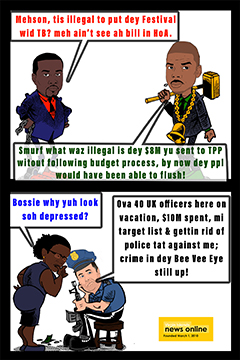Defeating the Deflation Beast
The return of John Maynard Keynes to the global economic conversation after his intervention in the 2008 financial recession is highlighted in the fact that Global deflation is a powerful and destructive beast. It is a monster that remains untamed. However, it is a monster that is proving the indestructibility of Keynesian ideas and his consumer driven economics model.
Infrastructure Stimulus is public spending on bricks and mortar, and roads and bridges. It is a way of ensuring that government spending touches a critical mass of consumers at the level of the high street, in order to positively impact economic growth. It is a method of getting cash into the pockets and purses of Jack and Jill Average: the mighty working and middle class.
Infrastructure Stimulus coupled with Fiscal Stimulus, is increasingly viewed by the experts as the solution to a global deflation crisis of historic proportion.
And make no mistake. Austerity and trickle down, the offspring of supply sided economic theory, has hit the proverbial wall as of early 2016. It has run off the road and on to the sidewalk where it is permanently stuck.
Today, the biggest threat to economic growth is not war, or terrorism. It is another beast entirely. It is a monster called DEFLATION.
Policymakers worldwide, including the managers of the mighty Federal Reserve, the IMF, World Bank, and the European Central bank, will have to factor in deflation before any policy proposals can be drawn. In fact deflation is becoming the greatest threat to the US economy, and global markets, since the Financial Recession of 2008. Policymakers everywhere will have to factor in deflation in their policy and strategy analyses.
One optimistic note is that presently borrowing and labor is cheap. Governments should use the shock absorbers of debt and deficit to increase public investment. During a deflationary period when interest rates are rock bottom such as is the case presently, governments have greater leeway to borrow and invest. Global investors also view government securities as safe havens.
All around the world prices on most products are falling. These prices are not falling because of increasing competitiveness, the normal way for showing economic dynamism and consumer confidence. They are falling because of falling consumer demand: the last thing businessmen and politicians need. Prices are falling for the wrong reason. Moderate inflation is an indicator of economic health. Disinflation is a slowing of inflation and is deemed normal. Deflation, on the other hand is a forced and sustained fall in prices, is considered unhealthy for any economy.
OK. The shrinking middle class, and the growth of poverty in the west, especially the USA, is one reason for deflation in early 2016.
Many a gifted economist lays much of the blame for the depressed consumer at the feet of exponentially growing wealth inequality. Then, China is increasingly being sucked into the deflationary vortex as its debt mountain grows exponentially as its economy slows.
Now, Deflation is a downward economic spiral. It is highly psychological phenomenon. Economics is about human behavior. Consumers in a deflationary environment hold on to their cash. Fear is ubiquitous. And Jack and Jill Average are over cautious in their spending. The result is a broad slowdown of economic activity.
There is an even greater evil, however, in today’s deflationary environment. Consumers and governments have still not worked off the debt that led to the financial collapse of 2008. This is making the present deflationary problem much more difficult to fix.
Deflation is dangerous for the global economy. Why: because deflation reduces the supply of money and credit. Deflation also reduces demand, especially for big ticket items such as cars and washing machines. The greatest fear is that the deflationary virus spreads worldwide, leading to a global depression. Astonishingly, this is what appears to be taking place presently.
One great model for deflation is Japan. Japan’s deflation has been blamed on its aging population. This deflation began in the 1990s and remains a problem for Japan today. The country has had an ongoing and massive monetary stimulus programme to defeat the deflationary monster. It has not worked so far. Japan may need to use migration as a tool to fight its demographic challenge, importing millions of migrants to help man and service its economy.
Now Europe appears to be on the brink of a triple dip recession, which is another name for deflation. Europe’s deflationary problem is the result of the inflexibility of Germany and Euro Zone monetary management to decide on a vision of growth for the whole of Europe. It is also the result of austerity that has destroyed much of the European middle class, and created massive inequality.
Deflation leads to higher unemployment. This in turn puts pressure on consumers. Consumers refuse to spend and this in turn increases the deflationary spiral to the bottom.
Oil is a marker for global deflation. The reason is that the fall in the oil price and commodities is pointer to the fall in global demand. This fall in demand has been led by a fearful Chinese consumer burdened by debt. Another marker for deflation is the fact that global investors are hedging against a New Depression by purchasing vast amounts of US Treasury Bonds.
The yield on 10-Year U.S. Treasury notes dropped below 2 percent in July 2015, hitting the lowest level since May 2013. This signaled that deflation fears were appropriate, heightening investor demand for safe haven assets. Meanwhile, the price of gold - another asset often seen as a safe haven is rising.
In a deflationary environment, cash also becomes more attractive. It is not accident that the US dollar has surged against other major currencies in recent months.
So is there a cure for deflation. Economists have lit a lamp over Franklin Roosevelt’s New Deal when in the 1930s, trillions of dollars in present day value, were spent on US infrastructure, pulling the US economy out of depression.
Essentially the new deal was an injection of the economics of John Maynard Keynes’s ideas into the US economy. Relief was given to the poor. Banking and finance was reformed protecting small investors from future storms. Government poured cash into welfare and insured the unemployed. Government created 9 million jobs to build 650,000 miles of highways and roads. 125,000 buildings were built. Major projects saw the construction of bridges, tunnels, airports, and so on and so forth. Slums were abolished and new houses built for the poor and middle class. Then World War 2 happened and billions more jobs were created in the armaments industry.
After World War 2 ended in 1945, the U S beat its swords into ploughshares. Then, coupled with the effects of massive Federal Government Intervention in the form of Roosevelt’s New Deal, the greatest expansion of the middle class in modern history took place. This was the result of the Post War Industrial Boom. All of this was economic magic. In reality it was the consequence of the fiscal stimulus, and infrastructure spending ideas, from an English Economist named John Maynard Keynes.
Connect with Dickson Igwe on Facebook and Twitter












.png)
























2 Responses to “Defeating the Deflation Beast”